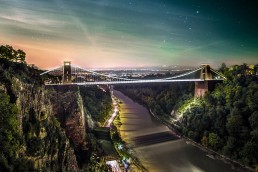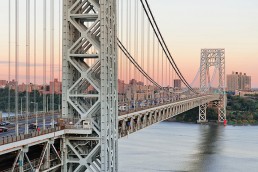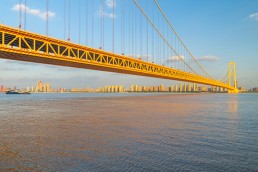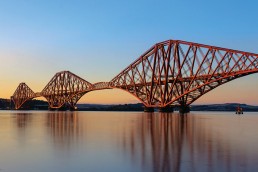© Stevie SpiersForth Road Bridge 1964
Forth Road Bridge 1964
The Bridge
During the 1950s, Freeman Fox was engaged to act as consulting engineers for the proposed Forth Road Bridge crossing in Scotland. Bill redesigned original plans for the bridge’s towers to incorporate Freeman Fox’s most recent research into new techniques for welded plate construction. His designs meant that the towers ended up weighing around 30% less than those of a more traditional design, which saved costs through reducing the amount of steel required.
The Forth Road Bridge was a 1,006-metre span, trussed-deck suspension bridge – the first major example outside America to be constructed after the Second World War. Freeman Fox worked jointly as consulting engineers with another British consulting engineering firm, Mott, Hay and Anderson (now known as Mott Macdonald). Freeman Fox oversaw the bridge’s superstructure, while the other firm concentrated on the foundations and anchorages.
The Forth Road Bridge Finished
On its completion in September 1964, the bridge over the Firth of Forth was the longest-span suspension bridge in Europe, and the fourth longest in the world. It stretched a total length of 2,515 metres, including the approach viaducts.
Forth Road Bridge
Europe's longest suspended span on completion
Key Facts
4-lane road bridge
Considerably lighter and economical than other bridges at the time.
Location
Queensferry, Edinburgh, Scotland
Across the Firth of Forth
Designers / Engineers
Dr William (Bill) Brown
Freeman Fox & Partners
Sir Gilbert Roberts
Mott, Hay, Anderson
Description
Suspension bridge
1,006m main span
1,824m total length
Main contractors
Reed and Mallik
Cleveland Bridge & Engineering Co. Ltd.
Dorman, Long and Co. Ltd.
Sir William Arrol & Co.
Construction
Began in 1958
Opened 4 September 1964
The Bridge Deck Design
Designs were based largely on contemporary American bridges, including the Golden Gate, George Washington and Verrazzano Narrows. It was a traditional lattice-deck design, but the updated engineering techniques pioneered by Gilbert Roberts, Bill Brown and the Freeman Fox team made it far lighter and more economical than any other bridge at the time.
The complex trusses used on the Forth Road Bridge, and earlier American bridges, were soon to be superseded by Bill Brown’s design for a streamlined box bridge deck. This was used for the first time on the Severn Bridge.
Lattice Truss Deck Design
































































